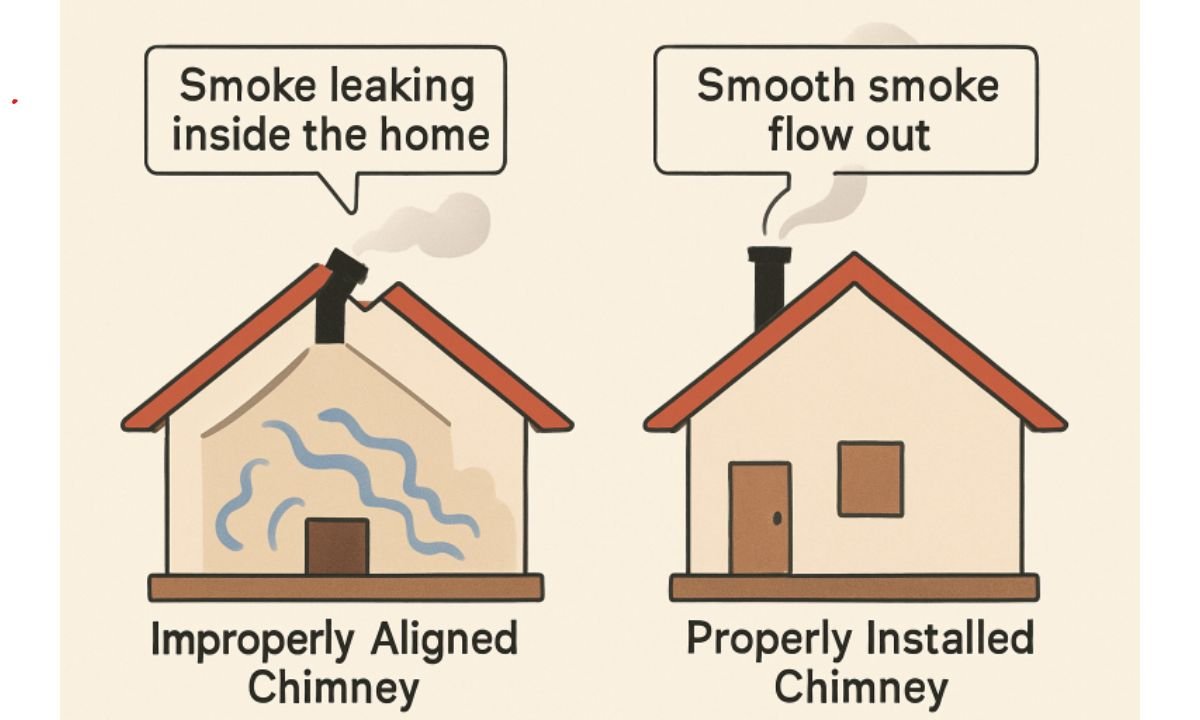Key Takeaways:
- Proper chimney installation is crucial for home safety, energy efficiency, and air quality.
- Incorrect installation can lead to fires, carbon monoxide poisoning, and severe structural damage.
- Common installation errors include using the wrong flue size, inadequate clearance from combustibles, and low-quality materials.
- Smoke leaks, strange odors, cracks in masonry, and excessive creosote buildup are warning signs of improper installation.
- Always hire certified professionals who follow local building codes and use high-grade materials.
- Regular inspections and maintenance significantly reduce long-term risks and costly repairs.
- Investing in professional installation ensures peace of mind and long-term home safety.
Introduction
Proper chimney installation is often underestimated, but even small mistakes can result in dangerous and costly problems for homeowners. Whether you’re embarking on a new build, a remodel, or simply upgrading an old fireplace, ensuring everything is done correctly is essential. Early attention to detail helps prevent hazards like house fires, poor air quality, and extensive home repairs. If you’re considering a new chimney or replacement, selecting a reliable chimney installation service can make a world of difference in safeguarding your family and your property for years to come.
An incorrectly installed chimney can quickly undermine your home’s efficiency and safety. Beyond the risk of fire, overlooked problems can affect air quality, add to your maintenance costs, and cause structural disruptions that devalue your property. Understanding these risks and knowing what to watch for allows you to prevent the consequences of improper installation.
Increased Risk of House Fires
Incorrect chimney installation is one of the leading contributors to residential fires. A misaligned flue, poor materials, or a chimney chasing too close to combustible framing can result in catastrophic outcomes. Recent reports from the Yukon have identified numerous house fires tied directly to improper chimney installation, highlighting the issue’s seriousness. In many cases, oversight or shortcuts taken during installation have led to decades-long risks that go unnoticed until it’s too late. Homeowners should be alert to this possibility and ensure that professionals thoroughly inspect their chimneys after installation.
Carbon Monoxide Poisoning
Another severe — and often invisible — risk of poor chimney installation is carbon monoxide poisoning. When a chimney can’t properly vent combustion gases, toxic fumes like carbon monoxide can accumulate in the living spaces. Unlike smoke, carbon monoxide is odorless and colorless, making it extremely dangerous. Prolonged exposure leads to headaches, respiratory issues, and can even be fatal. In homes with gas appliances or wood-burning stoves, a faulty vent system caused by improper installation is the main culprit for such hazards. The Centers for Disease Control and Prevention recommends installing detectors and demanding meticulous chimney inspections to counteract the risk.
Structural Damage to the Home
A poorly installed chimney can compromise not just the fireplace or stove configuration, but the entire structure of your house. Common symptoms include a leaning chimney, noticeable cracking in the brickwork, and even shifting of the roof or walls nearby. Missteps such as an ill-supported chimney base or incorrectly attached flashing can cause water damage, rot, and compromised structural support. Addressing chimney structural problems is usually far more expensive than getting the installation right first, underlining why expertise matters so much at the outset.
Common Installation Mistakes
Incorrect Flue Size
One frequent mistake is installing a flue improperly sized for the fireplace or heating appliance. If the flue is too small, exhaust gases can’t escape efficiently and will cause smoke and creosote to back up. Conversely, a too-large flue can result in poor drafting and incomplete combustion, accelerating creosote buildup and fire risk.
Insufficient Clearance from Combustibles
Chimneys must be separated from combustible framework, insulation, or finishes by a required minimum distance. When this isn’t observed, heat transfer over time can elevate the risk of ignition, even without direct flame involvement. Ensuring the proper clearance is a code-mandated step and one of the easiest ways to avoid disaster.
Use of Low-Quality Materials
Trying to save on costs by using subpar materials during installation can result in premature wear, leaks, and more frequent repair needs. Always choosing certified, high-temperature-rated materials is indispensable for safety and longevity.
Signs of Improper Installation
Even after installation, several warning signs can indicate that your chimney may not have been installed correctly. Watch for smoke entering the home, unusual, persistent odors, excessive creosote deposits, or visible cracks and gaps in the masonry. Another telltale sign is walls near your chimney becoming unusually warm to the touch while the fireplace is in use. Detecting such problems early allows you to address them before more serious and expensive damage occurs.
Preventive Measures
Prevention starts with vigilance and expert guidance. Always hire certified professionals who are well-versed in local building codes to handle chimney installations. Insist on using only high-grade, industry-approved materials. Be sure your installer maintains the required clearance between the chimney and combustibles, and make regular inspections and maintenance a part of your home care routine. Scheduled inspections keep your home compliant and safeguard against long-term hazards that might otherwise go undetected.
Final Thoughts
The best way to enjoy the warmth and ambiance of a fireplace is by ensuring your chimney is expertly installed and regularly maintained. The cascading impacts of improper installation — from fire risk, carbon monoxide exposure, to expensive repairs — cannot be overlooked. Proactive engagement and education are key. With the right installation and maintenance plan, you can rest assured your chimney will deliver safe, cozy warmth for many seasons.
READ ALSO: How to Plan a Budget Friendly Kitchen Renovation

